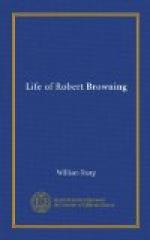Paracelsus, his friends Festus and his wife Michal, and Aprile, an Italian poet, are the characters who are the personal media through which Browning’s already powerful genius found expression. The poem is, of a kind, an epic: the epic of a brave soul striving against baffling circumstance. It is full of passages of rare technical excellence, as well as of conceptive beauty: so full, indeed, that the sympathetic reader of it as a drama will be too apt to overlook its radical shortcomings, cast as it is in the dramatic mould. But it must not be forgotten that Browning himself distinctly stated he had attempted to write “a poem, not a drama”: and in the light of this simple statement half the objections that have been made fall to the ground.
Paracelsus is the protagonist: the others are merely incidental. The poem is the soul-history of the great medical student who began life so brave of aspect and died so miserably at Salzburg: but it is also the history of a typical human soul, which can be read without any knowledge of actual particulars.
Aprile is a projection of the poet’s own poetical ideal. He speaks, but he does not live as Festus lives, or even as Michal, who, by the way, is interesting as being the first in the long gallery of Browning’s women—a gallery of superbly-drawn portraits, of noble and striking and always intensely human women, unparalleled except in Shakspere. Pauline, of course, exists only as an abstraction, and Porphyria is in no exact sense a portrait from the life. Yet Michal can be revealed only to the sympathetic eye, for she is not drawn, but again and again suddenly silhouetted. We see her in profile always: but when she exclaims at the last, “I ever did believe,” we feel that she has withdrawn the veil partially hiding her fair and generous spirit.
To the lover of poetry “Paracelsus” will always be a Golconda. It has lines and passages of extraordinary power, of a haunting beauty, and of a unique and exquisite charm. It may be noted, in exemplification of Browning’s artistic range, that in the descriptive passages he paints as well in the elaborate Pre-Raphaelite method as with a broad synthetic touch: as in
“One
old populous green wall
Tenanted by the
ever-busy flies,
Grey crickets
and shy lizards and quick spiders,
Each family of
the silver-threaded moss—
Which, look through
near, this way, and it appears
A stubble-field
or a cane-brake, a marsh
Of bulrush whitening
in the sun....”
But oftener he prefers the more succinct method of landscape-painting, the broadest impressionism: as in
“Past the high
rocks the haunts of doves, the mounds
Of red earth from
whose sides strange trees grow out,
Past tracks of
milk-white minute blinding sand.”
And where in modern poetry is there a superber union of the scientific and the poetic vision than in this magnificent passage—the quintessence of the poet’s conception of the rapture of life:—




